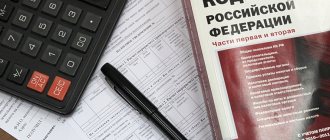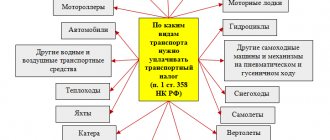Russian citizens, according to the letter of the law, are obliged to transfer to the state part of the funds they receive. In addition, tax collections are also carried out in other areas of life of a resident of our country. To a greater extent, this applies to payments for owning any property. This category includes securities, apartments, cars and other items. In this material we will take a detailed look at the transport tax, and also tell you how to independently calculate it in each individual case.
Transport tax: calculation
What is transport tax
The procedure according to which the transport tax is collected, as well as the timing of its payment, are regulated in the current year 2021 by a legislative act that came into force back in 2008.
According to this decree, Russian residents who own a vehicle are required to make annual payments to the state treasury so that the state, in turn, has funds to ensure the stable functioning of the country's road transport network.
In particular, funds received into the budget from owners of cars and other means of transportation go to the restoration of road surfaces, the organization of new highways, payments to service personnel and other equally important areas.
The annual transfer of money to the budget is made, contrary to popular belief, not only for the ownership of passenger cars. Vehicles also include:
- buses;
- scooter;
- motorbike;
- self-propelled transport;
- aircraft propelled by turbines and blades;
- water vessels equipped with a sailboat, motor and other elements;
- snowmobiles;
- tracked transport.
- motor sleigh;
- other means of transportation.
In terms of level, transport tax is classified as a regional deduction. Its size, method of payment and time frame for transfer to the state treasury are determined by the authorities of each subject of the country. In addition, they also determine the form of reporting that must be submitted for taxes.
At the federal level the following is carried out:
- determination of objects subject to the required fee;
- the procedure for calculating the financial base to determine the amount of the fee;
- time period for taxation;
- the procedure in which the fee under discussion is calculated;
- maximum and minimum bet values.
As mentioned above, objects subject to taxation include not only the passenger cars we are used to, but also public transport, motor vehicles, aircraft used privately and publicly, watercraft, self-propelled and towed, and the like.
We would like to draw your attention to the fact that vehicle owners who are obligated to make payments are not only people, but also various organizations. In the second case, both individual entrepreneurs and legal entities are required to pay.
As for the values of tax rates, they are set at the federal level, but the final values for each region are determined by representatives of its government structures
To determine the amount of tax, you need to know not only the rate, but also a certain base on the basis of which the final calculation is made. The basis is not the cost of the vehicle at which it was purchased, nor its current price. The measure for the formation of a charge is the power of a particular vehicle, which can be indicated in the following units:
- for cars and buses, as well as some watercraft and other machines of a similar design, the measurement is made in so-called horsepower;
- for jet engines, data is provided in kilograms - their thrust force;
- large shipping engines are taxed by registered tons;
- Other units of measurement are also used.
Among other things, the following elements influence the formation of payments.
- The type to which the vehicle belongs is one of the main characteristics for calculating tax. In addition, subtypes also matter. Thus, cars can be cars or trucks, water vessels can be represented by huge barges or elegant motor boats.
- The year of manufacture of the vehicle also plays a role. As items become obsolete, the tax rate applied to them also changes.
- The time period in which the vehicle is owned in the current tax period also plays a role.
- As mentioned above, the tax rate is determined individually for each region.
It was previously assumed that the sought tax levy would be cancelled. This event was supposed to happen within three years from the onset of 2009, however, this government decision was never made and, as a result, did not come into force.
According to the letter of the law of the Russian Federation, the rates used to determine the amount of tax will increase or decrease by 10 times. Among other things, rates can be differentiated for the following reasons:
- according to the vehicle category;
- a certain period of its useful use;
- provided that the owner of the vehicle belongs to the category of so-called beneficiaries.
The only category of vehicles that is not subject to the possibility of increasing or decreasing the rate tenfold are passenger cars whose engine power does not exceed 150 horsepower.
How it depends
What determines the amount of transport tax?
From the age of transport
The dependence of the fee on a vehicle on its production date is described in a letter from the Ministry of Finance of the Russian Federation dated January 18, 2012, number 03-05-05-04/01. The amount of the transport tax fee is directly determined by the age of the car.
The calculation of the vehicle age is taken into account on the first of January of the reporting period. The older the car, the higher the tax rate per horsepower.
From engine power
The next basis that is included in the calculation of the fee for a vehicle is the engine power of the car.
The rate depending on this indicator is considered regional and is set depending on the territory of the location of the vehicle and its territory in which it was registered.
However, you can notice a certain ratio that plays a role when calculating the fee for a vehicle.
If a car has a high power rating, then the rate will be higher than that of a car with a low engine rating. The minimum power of a vehicle, which is subject to taxation, is set at one hundred horsepower.
From the owner's registration
Depending on the registration of the citizen who owns the vehicle, a certain tax rate applies when calculating the duty on the vehicle.
The minimum rate is fixed by the current legislation of the Russian Federation. Depending on the region of residence, the rate may differ significantly from the legal amounts.
In order to clearly understand the difference in tax rates in different regions, let’s create a table:
| Vehicle power indicator | Established tax rate (per 1 HP) | Regional tax rate in Kemerovo (per 1 HP) | Regional tax rate in Novosibirsk (per 1 HP) |
| Up to 100 horsepower | 2,5 | 8 | 6 |
| From 150 to 200 horsepower | 5 | 45 | 30 (up to five years of use), 22.5 (5-10 years), 15 (more than 10 years) |
| From 200 to 250 horsepower | 7,5 | 65 | 60 (up to five years of use), 45 (5-10 years), 30 (more than 10 years) |
| More than 250 horsepower | 150 (up to five years of use), 112.5 (5-10 years), 75 (more than 10 years) | 15 | 135 |
| From 100 to 150 horsepower | 3,5 | 14 | 10 |
From the cost of the car
Federal Law No. 241-FZ of July 23, 2014 regulates the increase in the tax burden due to the ownership of an expensive car.
If the vehicle is considered expensive, then when calculating the duty on the vehicle, the increasing coefficient will be taken into account. Transport with a price tag of three million rubles is considered expensive.
In connection with this Federal Law, the following table can be compiled:
| Indicator of increasing coefficient | Car cost | Vehicle age |
| 1,1 | From 3 to 5 million rubles | From 2 to 5 years |
| 1,3 | From 3 to 5 million rubles | From 1 to 2 years |
| 1,5 | From 3 to 5 million rubles | Up to 1 year |
| 2 | From 5 to 10 million rubles | Up to 5 years |
| 3 | From 10 to 15 million rubles | Up to 10 years |
| 3 | From 15 million rubles | Up to 20 years |
The age of a car begins its calculation from the year in which the vehicle was produced.
It is worth understanding that there are no additional duties for owning an expensive vehicle; the coefficient is used in the general calculation of the amount of collection for the car.
An increasing factor when calculating the duty on a vehicle is provided only for expensive vehicles, and its cost must be at least three million rubles.
For other cars, the use of an increasing factor or any other changes is not provided. To understand whether a car is considered expensive, you should familiarize yourself with the list of expensive vehicles.
This list is determined by the Ministry of Industry and Trade of the Russian Federation. The list of expensive vehicles is updated no later than March 1 of the reporting period.
The list can be found on the official website of the Ministry of Industry and Trade.
From year of manufacture
The year of manufacture of the vehicle is considered the same factor as the age of the vehicle and is taken into account identically.
Calculation formula
Every taxpayer who has set this goal at least once can calculate transport tax. To complete the task, you need to know the formula for calculation and the meaning of its components in order to substitute your own indicators in place of each.
- First of all, you need to find out how much horsepower your car has. This indicator varies for all items, since each machine is equipped with a motor with a certain power. It’s easy to find out how many “horses” your car has. Just look at the passport of the technical device or its registration certificate and find out the indicator you are interested in. The required unit of power measurement is relevant for vehicles such as: cars;
- motorcycles;
- scooters;
- buses;
- motor boats, etc.
In the table below you can familiarize yourself with the tax rates specified in the Tax Code of the Russian Federation.
Tax rates from the Tax Code of the Russian Federation
Please note that the calculation of tax deductions, according to Law No. 248, from 2013 will be carried out at the place of registration of the individual.
If you find that the region has not established specific rates, then the values prescribed in the Tax Code of Russia will be applied.
So, the formula itself looks like this: A*B*C*D, where “A” is the horsepower of the vehicle, “B” is the current tax rate, “C” is the share of funds owned by a particular taxpayer, “D” is the time period of ownership of the car in a specific tax period.
With the onset of 2014, the provisions of the Tax Code of the Russian Federation concerning taxation in the field of transport have undergone some changes. It took place to establish specialized coefficients for increasing rates, relevant for vehicles whose value exceeds 3 million units of Russian currency.
The values of the increasing coefficients are presented in the table.
Table 1. Increasing coefficients for transport tax
| Cost of a car | Size of the multiplying factor |
| From 3 to 5 million rubles up to 3 years from the date of issue | 1,1 |
| From 5 to 10 million rubles up to 5 years from the date of issue | 2 |
| From 10 to 15 million rubles up to 10 years from the date of issue | 3 |
| From 15 million rubles to 20 years from the date of issue | 3 |
The formula for calculating the tax on “luxury” cars takes on an additional element. It looks like this: A*B*C*D*K. The rate that is relevant for a specific region of the country is multiplied by the engine power (number of horsepower). Then the resulting set is again multiplied by the indicators of the period of ownership of the vehicle and the size of the share of a particular taxpayer, and then also multiplied by a multiplying factor.
In our article we will discuss the luxury tax on cars in detail, and in general terms we will describe how it applies to real estate.
The more power the vehicle has, the higher the rate will be used when determining the amount of tax deduction. It follows from this that if you do not own a car, but a motorcycle or scooter, or other motorized transport, you will pay much less to the state treasury than motorists.
In addition, some constituent entities of the Russian Federation have introduced exemptions from transport tax payments for the following categories of vehicles:
- cars;
- motor transport.
Exemption is made only on the condition that the engine power of the required items does not exceed the legal limit
Calculation of transport tax 2021: benefits
Benefits that affect the calculation of transport tax in 2021 are established only by regional legislation. At the same time, the taxpayer declares the right to the benefit to his Federal Tax Service independently (clause 3 of Article 361.1 of the Tax Code of the Russian Federation). The Federal Tax Service may itself find out about the benefit through interdepartmental interaction with other authorities, but it is better to inform tax authorities about your right in advance.
For example, in Moscow, tax benefits in the form of the opportunity not to pay it for any one vehicle specified in the application for the benefit are established for individuals who are (Clause 1, Article 4 of the Moscow Law of July 9, 2008 No. 33 ):
- Heroes of the Soviet Union, Russian Federation, awarded the Order of Glory;
- veterans, disabled combatants, the Great Patriotic War;
- disabled people of groups 1 and 2;
- former prisoners of camps during the Second World War;
- recipients of benefits under the Laws of May 15, 1991 No. 1244-I, No. 175-FZ of November 26, 1998, No. 2-FZ of January 10, 2002 (Chernobyl victims, persons exposed to radiation, etc.);
- participants in nuclear weapons testing suffered radiation sickness.
The benefit is also given to one of the parents of a disabled child, one of the parents of a large family, one of the guardians of a disabled person since childhood who has been declared incompetent.
You also don’t have to pay tax:
- for one car with an engine power of no more than 70 hp;
- for any number of electric vehicles (the benefit is valid until 2024 inclusive).
If a person has the right to several benefits at once, then he chooses only one of them (clause 2 of article 4 of Law No. 33-FZ).
Let us consider, as an example, the calculation of transport tax for the year for a taxpayer who is a resident of Moscow.
Calculation examples
To make it easier for you to make calculations related to transport taxes yourself, we will give you a few examples.
Imagine that you own a car with an engine power of 140 horsepower. Let us assume that the rate relevant for the subject of the country in which the vehicle was registered is 3.5. You are the sole owner of the car. The period of ownership of the object is a calendar year.
The formula will look like this: 140 * 3.5 = 490. The final value will be the very amount of tax collection that the state expects you to receive.
If, at the time of determining the tax amount, the vehicle had not been in your possession for a full year, but only for seven months, the formula would have been as follows: 140 * 3.5 * (7:12) = 140 * 3.5 * 0.58 = 284 units of Russian currency.
Now let’s imagine that the cost of your car classifies it as a “luxury” vehicle, amounting to three and a half million rubles. Moreover, only four months have passed since its release. Then the calculation would look like this: 140 * 3.5 * 1.5 = 735 Russian rubles.
If your car was owned for only two months, and its price was 6 million Russian rubles, while the engine power was the same 140 “horses,” the calculation would be made as follows: 140 * (2:12) * 3, 5*2 = 166 rubles 6 kopecks.
Now let's consider the situation with a car with more power, and apply the general tax rate to it. Let's imagine that you own a car with an engine power of 270 horsepower, and the ownership period is a full 12 months. Then the value is calculated as follows: 270 * 15 = 4 thousand 50 Russian rubles.
If the car had been owned for 7 months less, the formula would have taken the form: 270 * 15 * 0.42 = 1 thousand 701 Russian rubles.
When a car with the required power is owned for a whole year, and its cost reaches 4 million, while only two and a half year periods have passed since the year of its production, the tax amount is calculated as follows: 270 * 15 * 1.1 = 4 thousand 455 rubles .
If the cost of the same car is raised to 12 million, provided that you have owned it for only six months, you need to calculate the tax according to the presented ratio: 170 * 15 * 0.5 * 3 = 6 thousand 75 rubles.
Above, you were presented with examples of calculating the amount of tax collection on cars. Now let's look at several problems in which the vehicle will be a motorcycle. Let's take the general tax rate.
You are the proud owner of a motorcycle, the ownership period of which is a full year. The power of the unit is 40 horsepower. The calculation formula is very simple: 40 * 5 = 200 units of Russian currency. If the period of ownership of the “iron horse” was only nine months, then the ratio of this period to a full year must be added to the required formula, that is, in fact, it must be multiplied by 0.75 (9:12). The result will be an amount equal to 150 rubles.
Note! The price of a motor vehicle is not a basis for changing the rate by adding an increasing factor to it.
Now let's try to give an example of calculating the transport tax for a bus. Let's imagine that the engine power of such a car is 300 horsepower. Let's take the rates from the general category. Let's assume you own this bus for a full year. Then the calculation will look like this: 300*10= 3 thousand Russian rubles.
If the period of ownership of the bus was only 8 months, then we add to the formula the ratio of this period to a full year, that is, 0.67 (8:12), multiply the indicators among themselves and get a value equal to 2 thousand 10 rubles.
As in the case of motorized transport, the price at which the bus was purchased is not the basis for changing the rate established by the Tax Code or other legislative act
Video - Calculation of transport tax
General rules for paying taxes in 2021
To calculate, you need to know several indicators:
- The rate, in accordance with its region, is set separately for each, based on engine size, environmental class and year of manufacture.
- Number of horsepower.
- Tenure period.
- Increasing factor for expensive cars, costing from three million rubles.
IMPORTANT! The tax service itself sends payment notices to citizens, and businesses calculate the tax themselves.
Vehicles not subject to taxation:
- Military equipment.
- Transport that carries government officials.
- Low-power cars with less than 100 horsepower, which were purchased with the assistance of government social protection agencies.
- Passenger and cargo vehicles owned by carrier organizations.
- Boats with oars, with a motor of less than 5 hp.
- Agricultural machinery.
Regional rates
The authorities of the constituent entities of the Russian Federation independently regulate the basic and increasing coefficients, which are used to calculate the amounts of transport tax for all its payers. According to statistics, changes associated with their magnitude are made annually. In addition, regional authorities can regulate the parameters of benefits provided to certain categories of citizens.
In each part of Russia, rates will vary greatly. Its value is directly dependent on the location of the region relative to the capital and the degree of its industrial development. The funds received by the local budget, collected through the transport tax, are further used to improve the conditions in which drivers “rotate” every day. In other words, this money is used to repair road surfaces, build new roads, and improve conditions for drivers in other ways.
Most often, the greater the number of vehicles in a particular region, the higher the tax rate that is relevant for this region will be.
Nuances related to the payment of transport tax
A citizen who owns a vehicle is obliged to pay transport tax before the end of the time period determined at the state level. Thus, individuals are required to deposit funds before December 1 of the year following the twelve-month period for which the deduction amount was calculated.
Since organizations are also taxpayers, they also have clear deadlines for making payments to the state budget. Thus, the Tax Code states that before the first day of February of the month following the taxation period of the year arrives, funds due to the country cannot be transferred.
The responsibility for determining the amount of tax deduction lies on the shoulders of the Federal Tax Service, to which the owner of the vehicle belongs. Once the amount has been established, the taxpayer will receive a notice from the tax service containing the following information:
- the amount of payment due to be sent to the country’s budget;
- details with which you can make payment;
- time frame within which the transfer of funds must be completed.
Tracking the completion of all transport tax payments is the responsibility of the Federal Tax Service
If the payment was not made on time, tax officials have the right to charge a penalty in excess of its amount.
If the car ceases to be used, however, it is not deregistered, even if it is dismantled for spare parts or processed as scrap, it will be necessary to continue paying tax deductions for it to the state automobile inspectorate.
Unfortunately, as in any other area of life, various confusion may arise when calculating tax and determining its base. The taxpayer must be able to independently calculate the amount of tax and monitor the accuracy of the calculations carried out by the tax inspectorate, and not leave everything to chance.
Transport tax for legal entities
As mentioned above, payments for transport tax should be made not only by ordinary people, that is, citizens of our country, but also by organizations whose legal form is a legal entity.
Companies can also be owners of vehicles that are on their balance sheet. In other words, payments must be made by companies that have passed the registration procedure with the state automobile inspection. It does not matter whether they own a car or another vehicle.
Even if a registered car is not used for its intended purpose, and simply sits idle in a garage, not generating income, until it is written off from use, after going through the appropriate official procedure, you will have to pay transport tax to the treasury.
Most often, the fee is charged on cars and trucks. In addition, companies often use buses to transport employees or clients. However, if a company has a specific focus of its main activity, it will have to pay fees on other types of vehicles.
Thus, yacht clubs provide boats, powerboats, and yachts for rent to clients, therefore, for each item they are required to pay transport tax to the state at established rates
We would like to draw your attention to the fact that only companies that own officially registered vehicles must make tax payments. If they do not own the vehicle, but rented it or received it on lease, then the obligation to pay the fee falls on the shoulders of the owner of the vehicle.
Compared to ordinary citizens who receive notifications from the Federal Tax Service at the end of the tax period, organizations are required to independently make the required calculations and determine the amount of deductions. The information received is entered into the declaration form, which is then submitted for verification to the tax authority that previously registered the legal entity.
Acceptance of documents starts no earlier than the first day of February of the following reporting year. Since the tax is in the nature of a local fee, the authorities of a particular entity have the right to introduce advance payments, which are required to be paid into the state treasury every three months of the organization’s operation.
Since companies are required to calculate the amount of the tax levy themselves rather than wait to receive a notice, the company accountant needs to understand the calculation method and know how to apply the calculation formula.
Please note that, as in the case of citizens’ personal transport, to obtain the required tax amount you need to know the following elements:
- the tax rate;
- the number of horsepower or other units of measurement of engine power;
- the time period during which the company owns the transport;
- Is it necessary to apply increasing coefficients in each specific case?
Let's give an example. owns a car of the famous German brand “BMW”. The desired vehicle was released in 2015. Its engine power is 102 horsepower. The price of the name was one and a half million Russian rubles. This means that no multiplying factor will be applied. The company is located and operates in the glorious city of Yekaterinburg. The current rate for it for 2017 was 9.4. According to the existing conditions, it is necessary to multiply the engine power by the desired rate. As a result, we receive a tax equal to 959 rubles.
Let's look at the second example. I bought a car in the spring, in March of this year, the brand of which is the famous Mercedes. The name was not purchased secondhand, but directly from the showroom. The engine power of the desired vehicle was 140 horsepower. The price of such an “iron horse” turned out to be very high. It is equal to 3 million 200 thousand rubles. As you can see, the cost of the car is the basis for applying the increasing factor. This company is also located in Yekaterinburg, where the transport tax rate is fixed and amounts to 9.4 units of Russian currency. It turns out that, taking into account the fact that the car was not owned for a full year, but was purchased in March, the final amount due for deduction to the budget was 1 thousand 645 rubles.
How is transport tax calculated?
Individuals do not have to worry about the amount of tax they will have to pay. The tax service makes the calculations independently. The taxpayer receives a notification of the need to pay on time in the form of a registered letter or notification on the State Services, as well as in the taxpayer’s personal account.
However, this does not mean that the tax amount is some kind of secret. If a citizen buys a car and wants to find out how much he will have to pay for it annually, you can use the calculator on the website of the Federal Tax Service. Those who do not trust government officials can make the calculations themselves
The vehicle tax formula generally looks like this:
Amount of transport tax = Regional rate * Engine power (hp)
And more precisely like this:
Amount of transport tax = Regional rate * Engine power (hp) * Period of use (months) * Increasing or decreasing factor
Those. If the vehicle ownership period is less than one year, another multiplier is added to the formula. It is equal to the number of months of ownership divided by 12.
The formula may also contain increasing and decreasing coefficients. For example, such a coefficient is provided for citizens who own cars worth more than 3 million rubles. All information on bets and odds is posted on the Federal Tax Service website.
Let's sum it up
Calculation of transport tax is a procedure that taxpayers must be able to perform. It doesn’t matter whether we are talking about a citizen of the Russian Federation or an entire company. In the first case, it is necessary to monitor the procedure for your own good. Any organization, including the Federal Tax Service, can make mistakes, and in the end, you will be forced to overpay significantly.
As for companies, they must independently calculate the amount of the tax due to the state and send it to the treasury. To avoid fines and penalties, you must do it correctly, otherwise you will be considered a willful defaulter.
The calculation is easy; to do this, you just need to use the formula presented in the article you are looking for, substituting your own indicators into it. Be confident in your abilities, practice using third-party examples and everything will work out.










